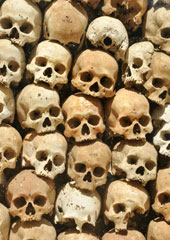Islamic Tribes: Testimonies of Genocide
Are countless acts of genocide the destiny of the human race?
April 8, 2013

Acts of genocide not only challenge their victims but all those who must contemplate the consequences of these actions. This was evident in the following letter, sent to me from an anonymous author after reading the op-eds in Al Jazeera written by my team and myself about the suffering of these beleaguered communities:
“I felt ashamed to not have known about their struggle for existence. I wonder how these people cannot become terrorists or rebels if faced with such inhumane conditions. The question is how would we react if faced with a situation they are in. I can only pray to Allah to protect all of us from this test. For sure, most of us would fail in this test.”
The anonymous writer had raised a pertinent question. Genocide had been taking place in history and was again recurring.
What is new is the increased frequency and intensity of genocide as far as tribal societies are concerned. If every tribal community is like a bounded world of its own, then the obliteration of literally hundreds of worlds becomes possible. The scale of suffering can be illustrated in numerous examples.
The author’s daughter, Nafees Ahmed, reads an excerpt from The Thistle and the Drone at the Brookings Institution in Washington, D.C.
In the 1860s, Russia killed 1.5 million Circassians, half of their population, and expelled the other half from their lands. In the 1940s, the Soviet government loaded the entire Chechen population of 400,000 on trains to Kazakhstan, killing half in the process. More than 100,000 were killed in the wars after 1994, or 10% of the entire population.
In the first four decades of French colonial rule, two million Algerians, two-thirds of the population, were killed. From 1930 to 1933, the Italians killed 50,000 Cyrenaica tribesmen in Libya and, in total, reduced the population by two-thirds as a result of death and displacement.
Between 1868 and 1900, some five million Oromo, or half the population, were killed in Ethiopia, with an additional half million killed in the Oromo Bale region in the 1960s. In the 1990s the Sudanese government killed as many as 500,000 Nuba, half of the population, and as many as 400,000 Darfuris in the early 2000s.
These figures convey a stark reality: If Muslims are an embattled species in the modern world, Muslim tribesmen are an endangered species in it.
Because these staggering statistics involve hundreds of thousands of people, if not millions, they are numbing and difficult to comprehend. Perhaps individual cases will throw the horror of genocide in sharper relief.
Consider the two children in Waziristan who saw their father shot in the head during indiscriminate firing by Pakistani security forces when he took the children shopping at a bazaar: “The children were covered in blood and brains of Yaqub Shah, they saw their beloved father, head shattered, lying in a pool of blood with no one to help them. For hours, the terrorized children sat by the dead body of their father, eyes wide open, not able to cry, not able to speak.”
Or consider the Fulani Muslims of the Middle Belt region of Nigeria who became victims of cannibalism by Berom tribesmen making matter-of-fact comments on video while police watched passively: “I want the heart” and “Did you put some salt?”
Or hear a Russian soldier describing what his fellow soldiers were doing in Chechnya: “One guy pinned a Chechen to the ground with his foot while another pulled off his pants and with two or three hefty slashes severed his scrotum. The serrated blade of the knife snagged the skin and pulled the blood vessels from his body. In half a day the whole village was castrated, then the battalion moved out.”
Or listen to Fatoumata, the brave young Fulani woman, who relived her ordeal at the hands of security forces chanting “We are going to exterminate you, Fulani” in the notorious episode at the stadium in Conakry, Guinea.
“A police officer, after raping me, decided to urinate in my mouth, as if it was part of their program,” she recounted. “I received streams of urine all over my face. After, they used sticks to rape me again with these objects. Then, finally, one tried to stab me in front, on the private parts.… The blood began to flow and I was so exhausted that I could not scream or cry.”
Or hear the courageous Kashmiri woman recalling the night the women of her village were gang raped by the Indian Army: “The army entered our houses at ten in the evening and left at nine in the morning.… There were screams everywhere — from almost every house in the village.”
Or contemplate the bodies of dead Baluch men with lettering freshly carved into their chests declaring “Long Live Pakistan.”
It is difficult to believe that these are not chronicles and legends of ancient peoples visited by demon barbarians, but rather what is happening today. People on the periphery have been traumatized beyond imagination in recent years.
They have been cooked and eaten. Their women have been gang raped in front of them. Their young men, elders, and religious teachers have been humiliated, tortured and killed. Their houses of worship have been destroyed. They have been relocated away from their homes and their lands stolen from them.
They face widespread famine and disease and are voiceless and friendless in a hostile world. They have been called “insects,” “snakes” and “reptiles.” They have been robbed of their dignity and honor.
They have seen their young men and women transformed into suicide bombers killing women and children, passengers in buses or worshippers in a mosque in a frenzy of anger. Yet the world seems indifferent to their suffering and is barely aware of its scale. This is indeed the dark side of the soul of man.
After the grim and relentless litany of woes I have just related, it is hard not to cry with Joseph Conrad: “The horror! The horror!”
It should give everyone pause to reflect on the fate of humans and ask: Is this where they were meant to arrive? In the end, will they be defined by little more than their indubitable capacity to breed and kill?
Editor’s note: This article is adapted from The Thistle and the Drone: How America’s War on Terror Became a Global War on Tribal Islam (Brookings) by Akbar Ahmed. Published by arrangement with the author and the Brookings Institution Press. Copyright © 2013 by Akbar Ahmed.
Takeaways
It is difficult to believe that these are not chronicles of ancient peoples visited upon by demon barbarians, but rather what is happening today.
Genocide has been taking place throughout history. What is new is its increased frequency and intensity as far as tribal societies are concerned.
Two terrorized children in Waziristan sat by the dead body of their father, eyes wide open, not able to cry, not able to speak.
Read previous

Democracy Goes into Reverse
April 6, 2013
